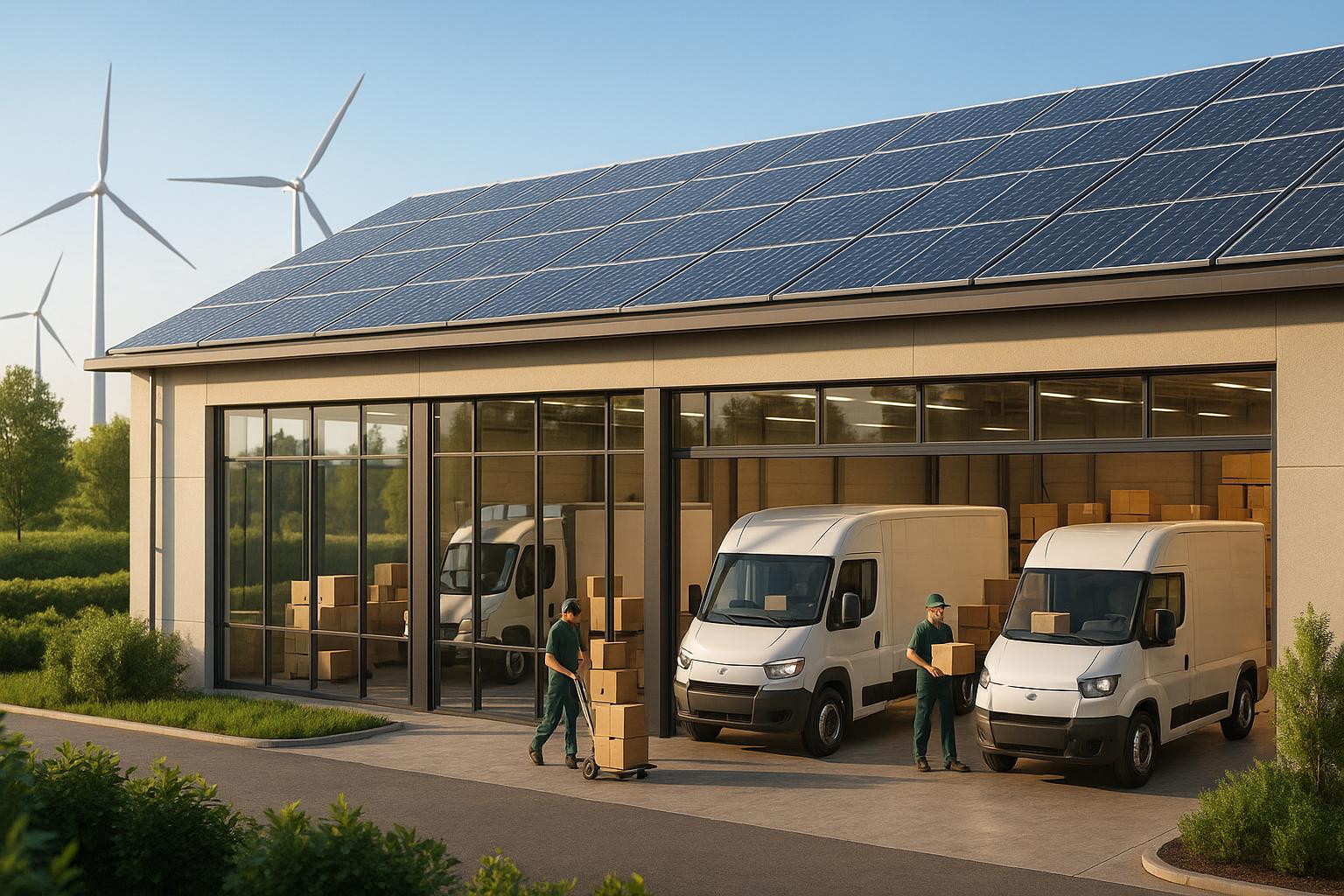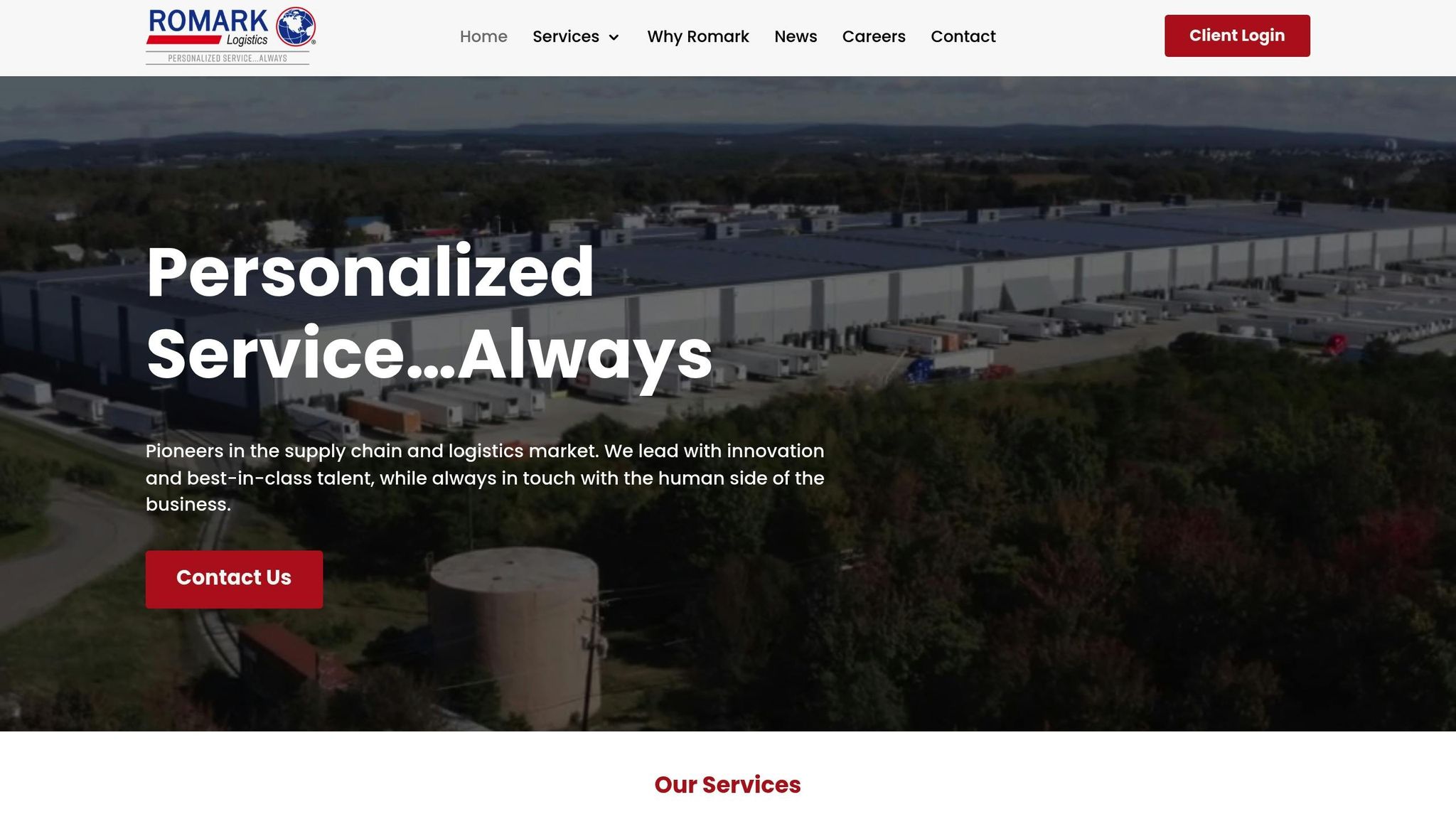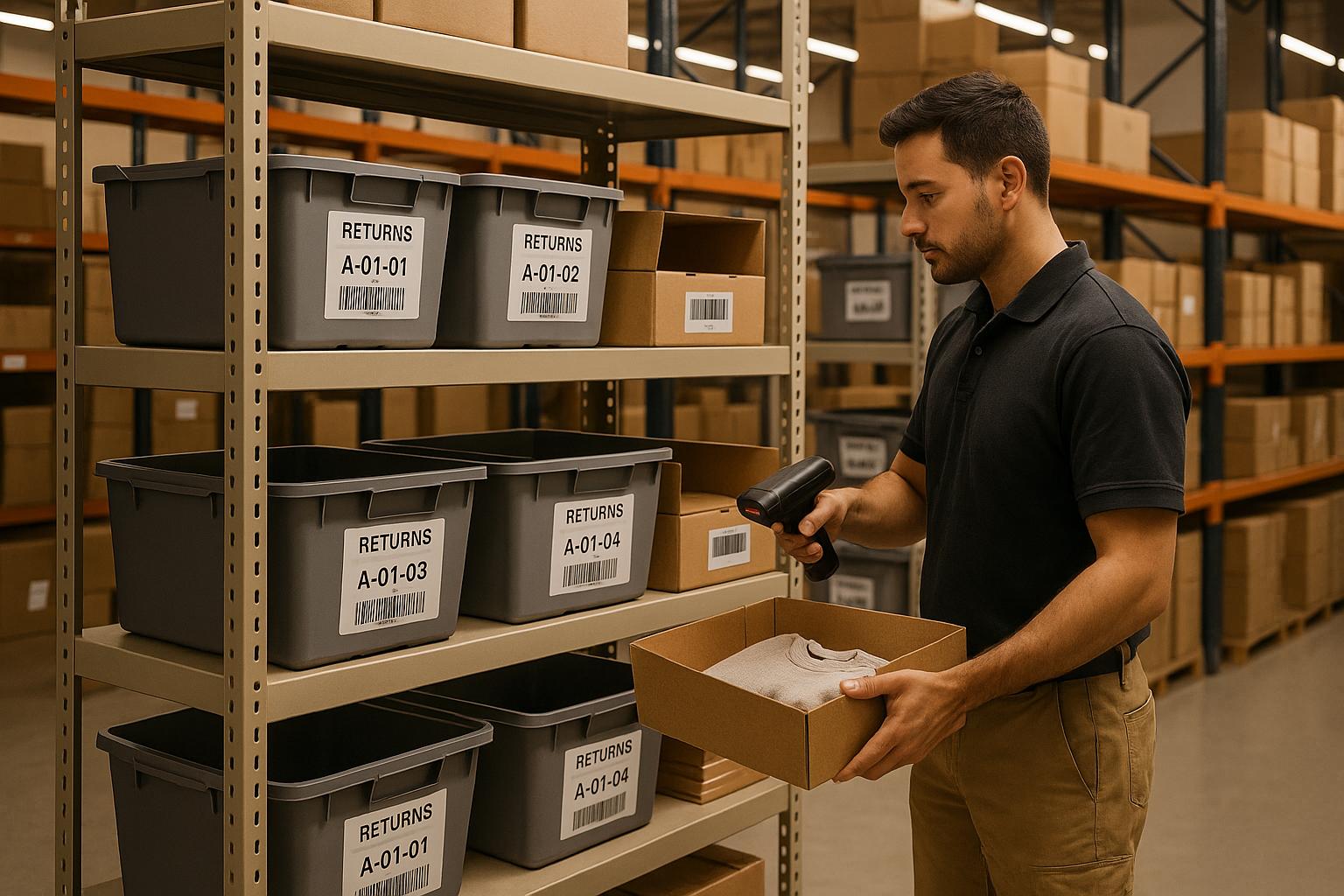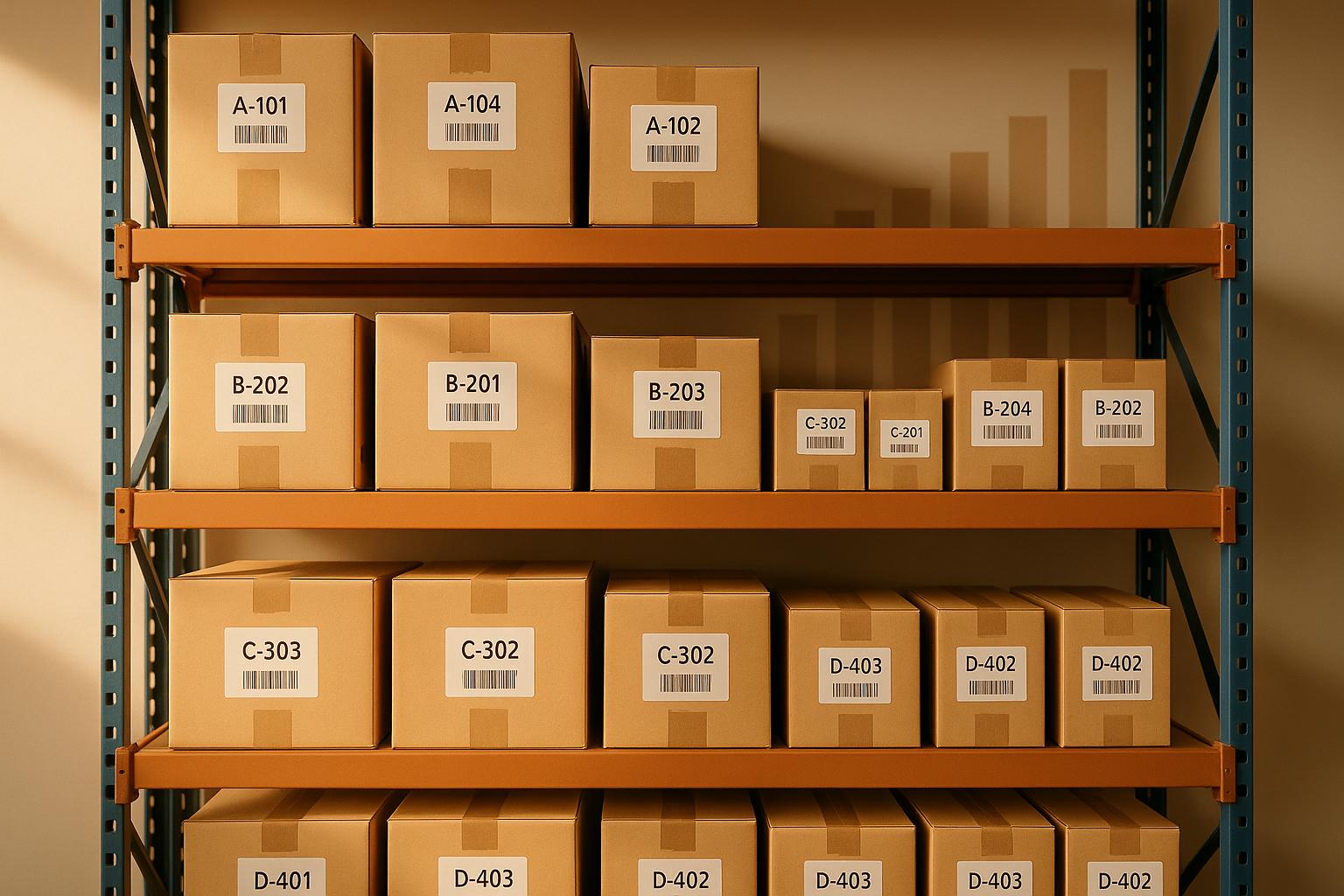3PL Role in Sustainable Energy Practices

Logistics accounts for 14% of global greenhouse gas emissions, making it a major contributor to climate concerns. Third-party logistics (3PL) providers are stepping up to address this challenge by reducing energy use and emissions across transportation, warehousing, and packaging. Here's how:
- Energy-efficient warehouses: LED lighting cuts energy use by 75%, while solar panels offset up to 75% of annual energy needs. Smart HVAC systems and lithium-ion batteries improve operational efficiency.
- Greener transportation: Electric and hybrid fleets reduce emissions by up to 43% compared to diesel vehicles. AI-powered route optimization lowers fuel consumption by 15%.
- Eco-friendly packaging: Right-sizing packaging reduces waste, while materials like corrugated cardboard and kraft paper offer recyclable alternatives to plastics.
- Collaborative supply chains: Partnerships between 3PLs, suppliers, and businesses focus on shared goals like reducing emissions and improving resource use.
Sustainability Practices within Romark Logistics | Supply Chain Sustainability Solutions

Energy-Efficient Facility Design and Operations
3PL providers are transforming warehouses into energy-efficient hubs that support sustainable logistics. Through smart design and advanced technologies, these facilities aim to reduce environmental impact while lowering operational costs. These innovations pave the way for exploring cutting-edge technologies, real-time management systems, and waste reduction strategies.
Energy-Efficient Technologies in Warehousing
Sustainable warehouse operations often start with lighting upgrades. LED lighting systems have become a popular choice for 3PL facilities, offering a lifespan 25 times longer than traditional bulbs and reducing energy costs by up to 20%. For instance, in December 2025, Kenco Group advocated for LED upgrades across its facilities, showcasing how improved lighting can lower both energy expenses and carbon emissions.
Smart HVAC systems are another game-changer in energy management. These systems adapt in real time to occupancy levels, weather conditions, and schedules, minimizing energy use during off-peak hours.
Solar panels are also gaining traction in warehouses across the country. These renewable energy systems can offset as much as 75% of a facility's annual energy consumption, reducing both costs and dependence on the grid.
Electrification of equipment is further enhancing energy efficiency. Lithium-ion batteries, for example, are now widely used in forklifts and other material-handling equipment. They last up to five times longer than traditional lead-acid batteries, cutting energy use, lowering maintenance needs, and improving reliability.
Real-Time Energy Management Systems
In addition to hardware upgrades, real-time energy management systems (RTEM) are revolutionizing how 3PL providers monitor and optimize energy use. These platforms combine advanced control technologies with expert services to help facilities minimize energy consumption while maintaining high operational standards. By providing instant insights into energy usage patterns, RTEM systems allow facility managers to make quick adjustments when energy use exceeds set thresholds.
Historical data plays a key role in these systems, helping identify inefficiencies and recommend adjustments based on past performance. For example, one client used an RTEM system to monitor 146 priority targets, saving $630,000 and cutting energy consumption by 22 million kW. Similarly, a review at the Acuity Brands Lighting Midwest Distribution Center revealed that only 75% of its forklift fleet was necessary, enabling the center to reduce fleet size and reinvest in lighting improvements.
Building Energy Management Systems (BEMS) take automation a step further by integrating IoT devices across facilities. These systems adjust HVAC settings based on real-time occupancy data and external weather conditions, offering actionable insights through user-friendly dashboards.
Materials and Waste Management
Sustainable operations go beyond energy efficiency to include waste reduction. Many 3PL providers have implemented recycling programs and optimized inventory placement. By conducting internal audits, warehouses can assess inventory placement and usage frequency, improving storage layouts and reducing unnecessary movement.
Responsible materials handling focuses on reducing, reusing, and recycling throughout operations. This includes setting up recycling stations, training employees on waste segregation, and partnering with certified recycling facilities. Employee engagement is also crucial - awareness campaigns promoting behavioral changes can cut energy use by up to 10%. These efforts highlight the importance of combining human action with technological advancements to achieve sustainability goals.
These facility-level upgrades not only drive cost savings but also form a solid foundation for broader sustainability strategies in modern 3PL operations. By integrating energy-efficient technologies, real-time monitoring, and effective waste management, providers can achieve measurable environmental benefits while maintaining top-tier performance.
Transportation and Route Optimization
While energy-efficient facilities help reduce costs, the largest environmental impact in logistics comes from on-road transportation. In 2021, transportation was responsible for about 24% of direct CO₂ emissions from fuel combustion, with road vehicles accounting for nearly three-quarters of these emissions. Shifting focus from facility energy management to dynamic, technology-driven transportation solutions is essential for achieving broader sustainability goals.
Electric and Hybrid Fleets
The move toward electric and hybrid vehicles is reshaping sustainable transportation. Electric trucks, for instance, produce 19–43% fewer greenhouse gas emissions than diesel trucks and have zero tailpipe emissions. Beyond environmental benefits, switching to alternative energy fleets can slash fuel costs by 55%. A case in point: New York City reported that maintaining an electric vehicle costs less than $400 annually, compared to $1,600 for a traditional vehicle. Over its lifetime, an electric vehicle can save approximately $14,480 in fuel costs.
While electric trucks come with higher upfront costs, government incentives and long-term savings help balance the investment. Managing hybrid fleets effectively requires centralized systems to address their unique maintenance and energy demands. Success hinges on fleet management platforms that enable dynamic dispatching, predictive maintenance, and performance tracking across both electric and traditional vehicles.
"Reliability is the most pressing concern in the trucking industry." – Michael Scheib, head of electric trucks for Daimler Trucks North America
Route Optimization Technologies
AI-powered route optimization technologies are transforming logistics by reducing fuel use and emissions. These systems analyze real-time data, such as traffic, weather, road conditions, and vehicle specifications, to optimize routes. The results are impressive: fuel costs can drop by up to 15%, and greenhouse gas emissions can decrease by 10% monthly [18, 19].
For example, an international logistics company implemented an AI-driven route optimization system across a fleet of over 60,000 vehicles. The system reduced fuel consumption by 7%, avoided 100,000 metric tons of CO₂ emissions annually, and saved $50 million in fuel costs each year. Similarly, an e-commerce company specializing in same-day deliveries achieved a 15% reduction in miles driven per package and a 20% cut in fuel consumption for its last-mile fleet.
"AI has significantly enhanced our fleet management at Wheelz Up by automating real-time decision-making and streamlining operational efficiency." – Jeb Lopez, founder and CEO of Wheelz Up
In 2025, Wheelz Up utilized Geotab's AI tools to monitor fuel usage and driver behavior. This technology improved fuel efficiency and provided real-time updates for dynamic rerouting, reducing idle times and enabling targeted driver coaching.
Alaska Airlines also demonstrates the potential of route optimization. Using the Flyways AI platform, the airline optimized routes for 55% of its flights, achieving 3–5% fuel savings on flights longer than four hours. In a single year, these improvements saved over 1.2 million gallons of fuel, equivalent to 11,958 metric tons of CO₂ emissions.
"Being a dispatcher requires attention to detail, problem-solving skills, and quick thinking... That's why we are grateful to have Flyways AI to help us optimize our routes, save fuel, and reduce carbon emissions. Flyways AI gives us more confidence and flexibility in our decisions and allows us to focus on delivering excellent service to our guests." – Captain Bret Peyton, managing director of network operations control at Alaska Airlines
Nationwide Network Integration
A robust nationwide network allows third-party logistics (3PL) providers to maximize transportation efficiency while minimizing environmental impact. JIT Transportation exemplifies how strategic positioning and advanced technology can support sustainable logistics on a national scale.
These networks often operate on a hub-and-spoke model, where each member manages specific geographic areas for collecting and delivering goods. This setup enables companies to share transport space, cutting shipping costs, speeding up deliveries, and reducing carbon emissions through load consolidation.
"Every time we're running a truck that's empty, someone's running a truck that's empty to a place to go pick something up and come back, you know, that's a wasted opportunity in our minds to do better for the planet." – Scott Evans, Director of Product at RunBuggy
JIT Transportation leverages its extensive network of strategically located warehouses and connected carriers to optimize routes. This infrastructure minimizes empty miles, enhances fuel efficiency, and streamlines logistics planning. By integrating advanced technology and nationwide coverage, JIT achieves levels of efficiency and sustainability that individual carriers cannot match.
Through optimized load consolidation and other eco-conscious strategies, these networks significantly reduce fuel use and emissions. When combined with other environmentally friendly practices, they contribute to a more efficient and sustainable logistics chain.
Eco-Friendly Packaging and Value-Added Services
In addition to improving transportation methods, 3PL providers are stepping up with sustainable packaging solutions and efficient fulfillment processes to lessen their environmental impact. With both consumers and businesses showing a growing interest in environmentally conscious fulfillment, packaging offers a major opportunity to make a difference. These eco-friendly packaging strategies work hand-in-hand with energy and transportation improvements to shrink logistics' overall carbon footprint.
Eco-Friendly Packaging Materials
Packaging waste is a significant environmental challenge, especially since 70% of recyclable plastics in Europe and 40% of globally traded wood often end up as waste. Sustainable packaging aims to address this issue by being safe, efficient, and optimized for energy and material use throughout its lifecycle.
Materials like corrugated cardboard stand out for their durability and recyclability. Other sustainable options include kraft paper, water-based inks, and recyclable tapes, which provide secure packaging while keeping environmental impact low.
"Regardless of what you need to package or ship, there is some eco-friendly option available that can meet your needs." – Nefab
Paper, in particular, is a strong alternative to single-use plastics. It’s renewable, recyclable, and offers reliable protection during shipping, all while helping to reduce waste [34,35].
Reducing Packaging Waste
Right-sizing packaging is one of the simplest yet most effective ways to cut down on waste. By tailoring packaging dimensions to fit products closely, 3PL providers can eliminate unnecessary materials, reduce shipping costs, and lower their environmental footprint. Minimalist packaging strategies focus on using only what’s essential to protect items during transit, avoiding excess materials.
Value-Added Services for Sustainability
Sustainability isn’t just about materials - it’s woven into the value-added services offered by 3PL providers. For instance, pick-and-pack operations now incorporate eco-friendly materials and right-sized packaging to minimize waste.
Kitting and assembly services consolidate multiple items into a single shipment, cutting down on both packaging and transportation needs. Custom kitting can even replace individual product packaging with consolidated, sustainable alternatives.
Just-in-time (JIT) transportation takes this a step further by combining pick-and-pack, kitting, assembly, and testing with eco-conscious practices. These efforts ensure that businesses can adopt greener fulfillment methods without compromising efficiency or product quality. Testing and quality control services also play a key role, ensuring that sustainable packaging materials meet durability and performance standards, reducing waste from damaged goods and returns.
sbb-itb-eafa320
Supply Chain Collaboration for Sustainability
When it comes to sustainable logistics, collaboration across the supply chain is key. By integrating energy-efficient operations and smarter transportation strategies, businesses can unify their efforts toward greener practices. With 80% of total greenhouse gas emissions linked to supply chains, it's clear that teamwork between 3PL providers, suppliers, and customers is crucial.
However, only 5% of companies actively address the environmental impact of their supply chains. At the same time, consumer demand for sustainability is rising. For instance, 73% of Gen Z consumers are willing to pay more for eco-friendly products, and over 57% of all consumers are ready to adjust their buying habits to support sustainability. This creates a strong incentive for collaborative partnerships that not only benefit the planet but also drive business success.
Partnerships for Green Logistics
3PL providers are forging partnerships with suppliers, customers, and industry peers to create greener logistics systems. These collaborations focus on shared accountability and measurable goals, such as eco-friendly packaging and optimized transportation. By working together, stakeholders can exchange knowledge and implement sustainable practices throughout the supply chain.
For example, manufacturers and 3PLs can team up to use environmentally friendly packaging materials. Some 3PL providers even offer specialized services, like creating eco-conscious packaging and managing waste disposal in a way that prioritizes environmental care.
Transportation partnerships also make a big difference. 3PLs can help businesses improve transport efficiency by increasing fill rates, using higher-capacity vehicles, performing regular maintenance, and switching to cleaner fuels. They can also suggest alternatives like shifting from air freight to sea freight, relocating inventory strategically, and optimizing delivery routes for co-loading.
Another area of collaboration is carbon impact analysis. 3PL providers can assist in creating accurate carbon emission reports and help businesses track and manage their environmental footprint. This transparency ensures that all parties stay accountable and motivated to continuously improve.
A great example of collaborative success is the SmartWay Transport Partnership. Since its launch in 2004, this initiative has saved over $44 billion and prevented 139 million metric tons of emissions. These results highlight the power of unified efforts across sectors like transportation, warehousing, manufacturing, and retail.
ERP Integration and Inventory Optimization
Collaboration isn’t just about partnerships - it’s also about leveraging technology. Enterprise Resource Planning (ERP) integration plays a critical role in creating sustainable supply chains. By connecting digital systems with trading partners, companies can build more flexible and efficient operations. This integration allows for real-time data sharing on demand, capacity planning, and production requirements, which leads to better forecasting and inventory management.
Vendor-managed inventory (VMI) systems take this a step further. When 3PL providers manage stock levels through ERP systems, they can minimize overproduction, reduce waste, and lower energy usage in storage. For example, JIT Transportation combines VMI services with ERP integration to help businesses maintain just the right amount of inventory while reducing the environmental impact of storage and transportation.
Real-time data sharing is another game-changer. By providing instant access to key metrics, companies can make smarter decisions that cut down on waste and energy consumption. Technologies like AI, IoT, and blockchain further enhance this by enabling real-time optimization and compliance tracking.
Shared systems and processes improve supply chain agility and efficiency. This reduces the need for excess stock, cuts down on warehouse space, and limits expedited shipments - all of which help lower energy use and emissions. Setting clear, measurable goals for emissions reduction and energy efficiency ensures that all partners stay aligned. Engaging suppliers, regulators, and industry peers in these efforts establishes shared standards for sustainability.
Ultimately, collaboration in sustainable supply chains isn’t just about being environmentally responsible - it’s also a smart business move. Supply chains can account for up to 11.4 times a company’s direct emissions, often representing over 90% of total greenhouse gas emissions. By working together through integrated systems and shared accountability, businesses and their 3PL partners can significantly reduce this impact while boosting operational performance.
Measuring and Improving Sustainability Impact
Tracking progress in sustainability is essential for achieving measurable environmental benefits and cutting costs. The logistics sector contributes about 14% of global greenhouse gas emissions, presenting a clear opportunity for 3PL providers to make a difference by focusing on accurate measurement and continuous improvement. These metrics not only guide operational adjustments but also shape strategic decisions across logistics operations.
Key Sustainability Metrics
With advanced facility management and smart transportation systems, precise metrics now play a critical role in driving sustainable practices. Effective 3PL providers rely on these metrics to assess their environmental impact accurately. Among these, carbon emissions tracking is fundamental, as it helps pinpoint areas in the supply chain where improvements can be made.
Energy consumption is another key area. For instance, solar panels can offset up to 75% of annual energy use, while LED lighting systems cut energy consumption by as much as 75%. In transportation, optimized routing can reduce fuel consumption by up to 15%. Additionally, electric vehicles produce 50% fewer greenhouse gas emissions over their lifecycle compared to traditional vehicles, and biodiesel can slash lifecycle emissions by up to 86% compared to fossil fuels.
Metrics for water usage and waste management are equally important. Monitoring water quality and usage, as well as detecting leaks, helps conserve resources and safeguard public health. Waste tracking within circular frameworks allows companies to evaluate material flows, focusing on recycled content, renewable materials, and end-of-life strategies. Investments in circular economy infrastructure further enhance these efforts. Additionally, scenario-based climate risk assessments help businesses develop targeted strategies to mitigate both transitional and physical risks. Tools like ESG platforms and IoT sensors enable real-time tracking of energy usage, adding another layer of precision to sustainability efforts.
Continuous Improvement and Audits
The SMART approach - Specific, Measurable, Achievable, Relevant, and Time-bound - provides a framework for setting clear and actionable sustainability goals. Embedding these goals into business processes ensures steady progress.
Technologies like AI, machine learning, and IoT significantly enhance operational efficiency while reducing environmental impacts. Regular audits, including quarterly reviews and annual evaluations, help ensure that sustainability targets are met and adjusted as needed. By analyzing key performance indicators such as carbon emissions, order accuracy, and inventory turnover, businesses can proactively refine their strategies.
Business and Regulatory Benefits
Improving sustainability offers financial advantages that go beyond meeting regulatory requirements. Studies show that consumers are willing to pay 5–30% more for sustainable products, and 80% of shoppers are concerned about the environmental impact of their purchases. Better resource efficiency and streamlined operations not only reduce costs but also increase profit margins. Sustainable practices can also lower expenses tied to raw materials and last-mile delivery. Moreover, achieving lower emissions can unlock access to sustainability-linked financing and contracts.
A structured approach to measuring sustainability simplifies compliance with international labor and environmental regulations. By adopting greener transportation practices, the logistics sector could cut greenhouse gas emissions by 20% by 2030. Current technologies could potentially reduce logistics emissions by 40–50% within the same timeframe. These advancements enhance a company’s standing with financial institutions and government bodies, which increasingly favor businesses with strong sustainability credentials. Considering that supply chain emissions are, on average, 26 times higher than Scope 1 and 2 emissions, rigorous measurement and improvement efforts are critical. Tax incentives and other government-backed benefits further encourage investments in sustainable supply chain practices.
JIT Transportation integrates these measurement systems into its operations, leveraging advanced technology and scalable infrastructure to refine and validate its green logistics strategies. This approach helps clients achieve measurable sustainability goals while maintaining operational efficiency. By doing so, businesses can not only meet regulatory requirements but also demonstrate real environmental benefits and satisfy the growing demand for sustainable logistics solutions. These precise measurements drive innovation and ensure long-term success in the pursuit of sustainability.
Conclusion
The logistics industry is at a pivotal moment where environmental responsibility aligns with business goals. With the sector accounting for about 14% of global greenhouse gas emissions, 3PL providers like JIT Transportation are stepping up to redefine supply chain operations. By embracing sustainable and energy-efficient systems, they’re achieving tangible results while addressing environmental concerns. This shift builds on the technological advancements and efficiency strategies discussed earlier.
Key developments such as LED lighting, route optimization, electric vehicles, and biodiesel have significantly reduced energy consumption and emissions - by up to 75%, 15%, 50%, and 86%, respectively. These numbers highlight a clear path for businesses to cut costs while contributing to a healthier planet.
"Sustainability in logistics is evolving from an initiative to a core business strategy, and 3PLs are playing a crucial role in this transformation." - Anupa Rongala, CEO, Invensis Technologies
This transformation spans every aspect of logistics operations. From warehouses powered by solar panels to AI-driven transportation networks, 3PL providers are creating integrated systems that prioritize environmental performance. Tools like IoT sensors, automation, and real-time energy management systems allow for precise tracking and continuous optimization.
Consumer demand is fueling this shift as much as regulations. With over 65% of U.S. consumers seeking sustainable products and about 80% willing to pay more for them, businesses that collaborate with eco-conscious 3PL providers gain a competitive edge. Companies like Unilever, IKEA, and Patagonia have proven that sustainable logistics not only cut emissions but also enhance operational efficiency.
JIT Transportation exemplifies this new standard by combining cutting-edge technology, scalable infrastructure, and a nationwide network with energy-efficient practices. Their approach enables clients to meet environmental goals without sacrificing service quality or speed.
"It's impressive when logistics providers focus on reducing their carbon footprint through energy-efficient fleets or by using renewable energy for their facilities. I am particularly drawn to partners that prioritize energy management and renewable energy integration." - Adam Bushell, Director, AB Electrical & Communications
The future of logistics lies in collaboration - between 3PL providers, clients, and technology partners. Initiatives like circular supply chains, reverse logistics, and eco-friendly packaging are driving meaningful change. As stricter environmental regulations emerge and financial institutions favor sustainable businesses, the case for green logistics becomes even stronger.
This shift isn’t just about addressing today’s challenges. It’s about building a resilient, efficient logistics framework that thrives in a greener economy. By integrating advanced tools with sustainable practices, 3PL providers position themselves - and their clients - for long-term success in an increasingly eco-conscious marketplace.
FAQs
How do 3PL providers help reduce greenhouse gas emissions in logistics?
Third-party logistics (3PL) providers are making strides in cutting greenhouse gas emissions by focusing on energy-saving practices and boosting operational efficiency. They’re introducing measures like switching to low-emission or electric vehicles, fine-tuning delivery routes to cut fuel use, and integrating energy-efficient technologies in their warehouses.
On top of that, many 3PL providers are putting resources into green logistics solutions. This includes installing renewable energy systems at their facilities and using advanced software to reduce empty miles and streamline supply chain processes. These initiatives not only help shrink their carbon footprint but also push the logistics industry toward a cleaner, more eco-conscious future.
What technologies and strategies do 3PL providers use to improve energy efficiency in warehouses?
3PL providers are stepping up their game by adopting technologies and strategies aimed at improving energy efficiency in warehouses while reducing their environmental footprint. For instance, many are turning to LED lighting to cut down on energy use, installing solar power systems to tap into renewable energy, and utilizing automation systems to streamline workflows and reduce waste.
On top of that, they’re rolling out recycling programs, shifting to biodegradable packaging, and embracing paperless workflows to conserve resources. By incorporating renewable energy solutions and refining facility designs, these providers are making logistics more sustainable without compromising operational performance.
How do 3PL providers work with supply chain partners to promote sustainability?
Third-party logistics (3PL) providers team up with supply chain partners to introduce eco-friendly practices that reduce environmental impact while streamlining operations. This often involves smarter transportation strategies, like optimizing delivery routes, combining shipments, and boosting energy efficiency in warehouses and other logistics facilities.
By choosing carriers committed to sustainability and leveraging green technologies, 3PL providers play a key role in cutting carbon emissions, reducing energy use, and aligning with broader environmental goals. These collaborative efforts not only create a cleaner supply chain but also meet growing customer demands for environmentally responsible solutions.
Related Blog Posts
Related Articles

Top 3PL KPIs for Scaling E-commerce Brands

Best Practices for Returns Reconciliation in 3PL

